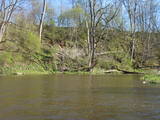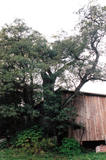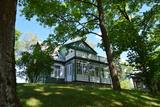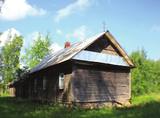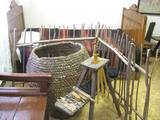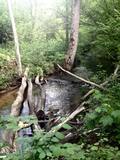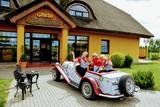| Nr | Name | Beschreibung |
|---|---|---|
|
Kleine Sandsteinaufschlüsse an den Ufern des Ciecere – Flusses. Hier wurden Fischfossilien gefunden.
|
||
|
Noch vor kurzem befand sich das Kabinett in dem ehemaligen Haus der Einigkeit von Sauka, wo die Berufsschule von Sauka hauste. Seit 2010 ist die mit dem Kabinett verbundene Ausstellung in die Räume der Gemeindeverwaltung von Sauka nach Lone versetzt worden. Mārtiņš Buclers (1866 – 1944) war der Grundleger der lettischen Fotografie, weil er das erste Unternehmen in Lettland gegründet hat, das Filme und Fotopapier hergestellt hat. Es ist wert, die Ausstellungsgegenstände heute – in dem digitalen Fotozeitalter – zu kennenlernen! An dem Haus der Einigkeit von Sauka (zurzeit geschlossen und nur von außen zu besichtigen) kann man den Gedenkstein und das DenkmalFotografie 150 besichtigen, die Mārtiņš Buclers gewidmet sind. |
||
|
This is the thickest Black Alder (Alnus glutinosa) in Latvia
|
||
|
Die museale Gedenkstätte für A. Baranauskas und A. Vienuolis-Žukauskas wurde 1927 begründet. Hier wird Material gesammelt, archiviert und gezeigt, welches die Kultur und Literatur der Gegend um Anykščiai, die Geschichte, die Entwicklung von Landwirtschaft und Technik in der Region zeigt. Die Besucher können das ganze Jahr über durch die Hügel des Schriftstellergedächtnisparks spazieren. |
||
|
This park is in a region of hillocks in the Karula highlands, and Lake Ähijärve is at its centre. The park offers a cultural environment of small farms, and it was set up to protect the unique cupola-shaped hillocks of the area. Main attractions: Scenic Lake Ähijärv (176ha), Rebasemõisa Tornimägi hill (137.8 m above sea level), undulating landscapes. |
||
|
Paramonovas Old-Believer Preaching House was built in
1882.
|
||
|
Z/s Kotiņi pamatnodarbošanās ir graudkopība ar specializāciju sēklkopībā. Vieni no lielākajiem sēklas ražotājiem valstī. Apsaimniekojamās zemes platība ir 4500 ha, no kuriem 3500 ha ir augstu kategoriju sertificētas sēklas lauki. Audzē kviešus, miežus, rapsi, pupas, zirņus, auzas, rudzus, eļļas rutkus, sinepes, griķus, āboliņu, sarkano auzeni, timotiņu, Speltas kviešus. Saimniecība piedāvā produktus ar pievienoto vērtību:
Daļa no Kotiņu produktiem ir atzīti ar zaļās karotītes kvalitātes zīmi! Kotiņi ir saimniecība, kur lieto Latvijā ražotu 100% zaļu enerģiju. |
||
|
Local History Museum of Nautrēni. Permanent exposition of the
local history of the district, school and parish.
Working hours: on request |
||
|
Atrodas 0,9 km no Jaunpiebalgas muižas pils, Jaunpiebalgas centra virzienā. Redzot šo ēku, nav jāpārliecina, ka tā ir viena no garākajām Vidzemē. Tik gara, ka grūti pat „iedabūt kadrā”. |
||
|
Das Café befindet sich im Keller des Museums der Schriftstellerin Anna Brigadere. Außenterrasse. Hier werden Partys zusammen mit den guten Hexen des Naturparks von Tervete und Fahrten mit einem Pferdewagen oder Pferdeschlitten angeboten. Lettische Küche: Schweinerippen in Honigsoße, Pfannkuchen mit Marmelade, Pilzsoße. Das besondere Gericht: Bärentatze. |
||
|
Das Unternehmen „Limbažu siers” hat mehr als 90 Jahre Erfahrung im Milchverarbeitungsbereich. Für die Herstellung von Käse wird nur Milch, die die einheimischen Bauer produziert haben, verwendet. Die technische Ausstattung stammt aus der Schweiz. 95 % der Erzeugnisse werden ausgeführt. In einem Geschäft in der Nähe vom Unternehmen, gegenüber den Ruinen der Burg von Limbazi, kann man die Erzeugnisse kaufen. |
||
|
The tree is in the middle of an untended field. Despite many dead branches and the messy surroundings, the tree is beautiful and well visible from the road. It is the third thickest tree in the Baltic States.
|
||
|
Im Wald von Kaltene ist ein sagenumwobenes Naturwunder – Kalvas von Kaltene bzw. von Valna zu besichtigen. Das Entstehen dieser Anhäufung im Wald, 2 – 3 km von der Küste entfernt ist mit den Küstenbildungen des Baltischen Eissees verbunden. Die größte Anhäufung ist Velna kalva (Teufels-Kalva). Seinerzeit war Velna kalva eine schöne Anhäufung, so große, dass “sich bis Gipfeln der Bäume streckte”. Auf den früheren Karten wurde die absolute Höhe dieser Anhäufung angegeben – 20 m. Diese Anhäufung bestand aus Steinen verschiedener Formen. Die Steine waren sowohl voll kugelförmig als auch in einer Tellerform. Diese Anhäufung wurde fast vollständig in den 1960er – 1970er Jahren vernichtet, da daraus die Schotter für Straßenbau gewonnen wurde. Heutzutage ist nur ein ziemlich kleines Fragment des Unterteils von Kalva erhalten geblieben. Die Länge dieses Fragments beträgt ca. 300 m, aber die Höhe – 2 m. Die Wissenschaftler äußern eine Meinung, dass diese Anhäufungen im Altertum Sakralorte sein könnten, da viele Sagen und Legenden sind darüber geblieben. Um die Anhäufung zu besichtigen, wurde einen Naturpfad mit den Informationsständen und einem nicht großen Parkplatz errichtet. (Die Quelle: Roja TIZ) |
||
|
The craftspeople produce interesting clay cups with text, drawings and animal figurines inside them. You can take a tour, watch the specialists at work, and engrave your own texts on dishware. You can also use gypsum moulds to create small animals, work with a potter’s wheel, purchase souvenirs, and order products for yourself. |
||
|
This is for birders who can’t afford to take longer breaks to enjoy birdwatching. Short but rewarding trip during spring migration. Cape Kolka is a place where pass the largest numbers of migrating birds in the spring time. More than several tenth of thousand birds cross the Cape each hour. During active period of migration it is possible to see more than 100 different species daily just at this one place. There are several birdwaching places located at different biotops – seaside meadows, sea cost and lakes and wetlands. Kemeri National Park is one of the best places for woodepecker watching. In a short period of time it is possible to see about seven species. |
||
|
1.2 km long, the trail passes through a unique terrain of hillocks and forests, with the height of the valley rising to as much as 15 metres. Visitors will find a diversity of plant life, as well as the beautiful little Kauliņupīte River, which crosses the rail at two points. The health trail was established in the late 1990s. |
||
|
Der Ort, dem sich der Hof befindet, ist nach der Erinnerung von Altansässigen das einstige Zentrum des Dorfes Domantai. Der Hof besteht aus 4 Gebäuden, die in der Tradition der regionalen Architektur stehen: Schenke, Speicher, Sauna und beidseitiges Wohnhaus. |
||
|
Ap 7 km garā apļveida taka sākas pie leģendārajām Mangaļu mājām. Tā iepazīstina ar latviešu strēlnieku kauju vietām, vietām, kur atradušās to fortifikācijas, t.s. „Vācu valni” u.c. liecībām. Mangaļu mājās – Ziemassvētku kaujām veltīts muzejs. |
||
|
This farm produces raspberries (6 ha), herbs, medicinal plants (more than 100 types), vegetables (red peppers, cucumbers, tomatoes, chili peppers, onions, garlic) and bees. The owner produces salads, jams, lecho and chutneys. You can purchase vegetable products, pick your own raspberries and strawberries, taste teas, buy honey, and receive valuable consultations. |
||
|
Diese Tour hat eine sehr sommerliche Atmosphäre, weil sie fast nur an der Küste führt. Der Kurort Jurmala in Lettland lockt die Reisenden mit seinen charakteristischen hölzernen Ferienhäusern aus dem 19. Jh., dem Konzertsaal Dzintari und den lebhaften Stränden. Das Kap von Kolka befindet sich im Nationalpark Slitere, zu dem auch die traditionellen Dörfer der kleinsten ethnischen Gruppe der Welt – der Liven – gehören. Genießen Sie die leeren Strände und das Vorort geräucherten Fisch. Ventspils ist eine tadellos gepflegte Stadt mit einer mittelalterlichen Burg und einem gut eingerichteten Strand. Die Stadt Pavilosta ist die inoffizielle Hauptstadt der Windsurfer in Lettland. |
||
